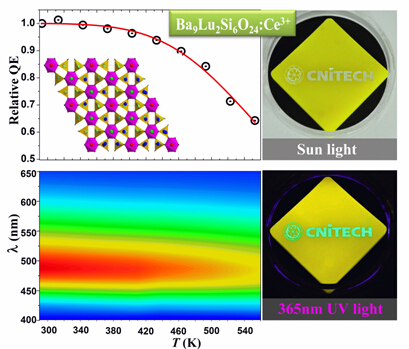LED-based solid state lighting devices have shown remarkable improvement in terms of robust, environment friendly, and, most importantly, energy saving features.And these devices are regarded as the replacement of traditional incandescent and fluorescent lamps. In recent applications, wavelength conversion phosphor is one of the key materials, and converts the light emitted from UV, violet, or blue LEDs into visible light. Phosphor plays an important role in determining the white LEDs performances, such as, color rendering, luminous efficiency, lifetime, and so on. Nowadays, a number of promising phosphors have been explored and their suitability in white LEDs has been demonstrated. In particular, nitride phosphors have been paid much attention due to their high chemical and high thermal stability. At the operating temperature of current white LEDs (~150 oC), nitride phosphors can maintain 80~90% of the room temperature luminescence intensity. Usually, nitride phosphors are synthesized by using solid-state reaction (SSR), gas reduction and nitridation (GRN), carbothermal reduction and nitridation (CRN), or high pressure ammonothermal methods. These synthesis techniques are often complex,requiring expensive and moisture-sensitive raw materials, a long processing time at a high temperature (1400~2000 oC), and a high nitrogen or ammonia pressure (100 MPa). all these techniques lead highly costs to produce these phosphors. therefore,it is till necessary to search novel phosphors with high efficiency, low thermal degradation, and can be synthesized easily.
Recently,Prof.Haochuan Jiang’s group,Jun Jiang and Dr. Yongfu Liu at the Ningbo Institute of Materials Technology and Engineering, Chinese Academy of Sciences develop a novel orthosilicate phosphor, Ba9Lu2Si6O24:Ce3+, which is synthesized by a simple SSR processing technology at a relatively low reaction temperature of 1200-1400 oC. The photoluminescence characterization identifies a main peak at 400 nm in the excitation spectrum, making it viable for the near-UV LED excitation. This phosphor exhibits a broad emission band with a width of nearly 120 nm, peaking at 490 nm. For the optimum Ce3+ concentration, the internal quantum efficiency (QE) is as high as 82%, which is equivalent to most nitride phosphors. Furthermore, nearly 94% of the room temperature internal QE is still maintained at 160oC, which is much superior to that of most nitride phosphors. The excellent thermal stability and luminescent properties show a promising candidate as a green phosphor for near-UV based white LEDs. The results have been published on Advanced Optical Materials(DOI: 10.1002/adom.201500078)

Prof. Haochuan Jiang: jianghaochuan@nimte.ac.cn Dr.Yongfu Liu:liuyongfu@nimte.ac.cn
All Images by![]()

